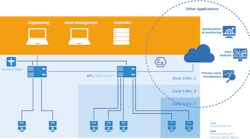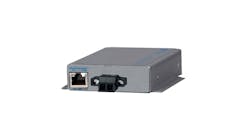To eliminate networking bottlenecks and let data flow freely, supporters of the Ethernet-Advanced Physical Layer (APL) organization have been working steadily for several years to bring Ethernet’s far higher speeds, more varied and voluminous data, and other IT-based benefits to inaccessible, harsh and hazardous settings (Figure 1).
“More than intrinsic safety (IS), Ethernet-APL is all about speed,” says Arnold Offner, strategic marketing manager for process automation at Phoenix Contact. “For example, where it usually takes eight minutes to extract a measurement from a Coriolis flowmeter using HART protocol or three minutes with Foundation Fieldbus protocol, Ethernet-APL can do it in less than 10 seconds.
While slower than regular Ethernet at 1 Gbps, Ethernet-APL runs at 10 Mbps, which is far quicker than protocols like Foundation Fieldbus or Profibus PA that operate at 31.25 kbps or HART that runs at just 1,200 bps.
Matt Smith, security engineer at system integrator E Tech Group, adds that, “Ethernet-APL’s development has been fueled by a unique set of economic and technical forces in the process automation industry. Key factors include harsh industrial environments, long-distance communication, deterministic communication, cost reduction and simplified installation, integration with existing Ethernet infrastructure, industry collaboration, and standardization efforts.” Headquartered in West Chester Twp., Ohio, E Tech is a certified member of the Control System Integrators Association.
Smith reports Ethernet-APL has several advantages over other networking technologies, particularly in process automation applications, though it also has some drawbacks and implementation requirements. “Ethernet-APL’s advantages include robustness and reliability, long-distance communications, deterministic communication, power over Ethernet (PoE), interoperability and compatibility. Its drawbacks include some bandwidth limits and initial implementation costs. Requirements for implementation include compatible devices and infrastructure, network planning and design, training and expertise, and compliance with regulations.”
Presence and power
Offner reports that Ethernet-APL switches employ one of the two power classes available for APL, namely Power Class A that runs at 540 milliwatts and Power Class B, which is almost double that amount. To ensure migration to Ethernet-APL, existing fieldbus Type A cabling can be used if it’s still robust.
“Regular Ethernet is OK for the office, where it’s hidden and distances usually aren’t very far. Furthermore, it’s unshielded, won’t last in harsh or corrosive environments, and its physical RJ45 connectors are not suited for reliable, in-the-field field connections,” says Offner. “This is why we keep plant-floor network links shielded with connectors that aren’t polarity dependent, and use screw connections or barriers blocks on field instruments.”
So, why not use regular Ethernet instead of Ethernet-APL? Though it runs at relatively low-power, Offner adds that regular Ethernet is still potentially risky in process applications, ambient conditions, or in mitigation strategies where intrinsic safety (IS) is needed.
“Zone 1 is challenging for Ethernet-APL or any network because they must address the ignition curve in the IEC Ex standard,” explains Offner. “In the past, fieldbuses addressed this with Fieldbus Non-Incendive Concept (FNICO) and Fieldbus Intrinsic Safety Concept (FISCO) couplings, which allow the low-power spur to connect with the corresponding APL field device. Today, IS has proven to be less costly than other protective methods, so it was made part of Ethernet-APL and its communication paths.”
To bridge the gulf between device-level components in hazardous areas and I/O, networks and controls above them—and hopefully use Ethernet-APL to do it—Offner reports that suppliers, system integrators and potential users alike must examine their capacitance, power, resistance, voltage, current and other factors. “We’ve worked to simplify both ends,” he says. “Working with APL, we now use matching port classes. Right now, the IEC TS 60079-47 technical specification describes using two-wire, intrinsically safe Ethernet (2-WISE). We’ve gone from traditional eight-wire/four-pair Ethernet to single-pair Ethernet (SPE) with just two wires, and Ethernet-APL with intrinsic safety is just an enhancement.”





